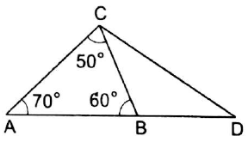In ∆ABC, side AB is produced to D such that BD=BC. If ∠B=60° and ∠A=70°, prove that (i) AD>CD and (ii) AD>AC.

Given: In ∆ABC, BD=BC and ∠B=60° and ∠A=70°
To prove: AD>CD and AD>AC
Proof:
In ∆ABC, by the angle sum property, we have
∠A + ∠B + ∠C = 180°
70° + 60° + ∠C = 180°
130° + ∠C = 180°
∠C = 50°
Now in ∆BCD we have,
∠CBD = ∠DAC + ∠ACB … as ∠CBD is the exterior angle of ∠ABC
= 70° + 50°
Since BC = BD …given
So, ∠BCD = ∠BDC
∴ ∠BCD + ∠BDC = 180° - ∠CBD
= 180° - 120° = 60°
2∠BCD = 60°
∠BCD = ∠BDC = 30°
Now in ∆ACD we have
∠A = 70°, ∠D = 30°
And ∠ACD = ∠ACB + ∠BCD
= 50° + 30° = 80°
∴∠ACD is greatest angle
So, the side opposite to largest angle is longest, ie AD is longest side.
∴AD > CD
Since, ∠BDC is smallest angle,
The side opposite to ∠BDC, ie AC, is the shortest side in ∆ACD.
∴AD > AC